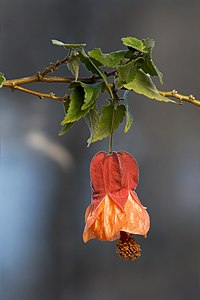
Abutilon × hybridum is a species name used for a wide variety of different types flowering plants of uncertain origin in the genus Abutilon. [1] [2] [3] Because of the uncertainty surrounding the name, they are often considered a cultivar group: Abutilon x Hybridum Group or Abutilon Hybridum Group. They are cultigens, not occurring in the wild. [4] [5] As with the larger genus Abutilon generally, they have been referred to by the common names Chinese lantern, [6] [7] and parlour maple.
-
Cultivar 'Moonchimes'
Description
No reliable source has settled the question of parentage for these plants, and they have been variously said to perhaps derive from the species Abutilon theophrasti, [8] A. striatum, [4] A. darwinii, [9] A. pictum, [9] or any of the South American species. [10]
Descriptions vary widely; some sources have described them as short as "1 to 2 ½' tall", while others list them as reaching 15' in height. [8] [11]
References
- ^ Spencer, Roger (1995). Horticultural Flora of South Eastern Australia Volume 2: Flowering Plants. UNSW Press. p. 373. ISBN 978-0-86840-303-8.
- ^ Cullen, James; Knees, Sabina G.; Cubey, H. Suzanne (2011). The European Garden Flora Flowering Plants: A Manual for the Identification of Plants Cultivated in Europe, Both Out-Of-Doors and Under Glass. Cambridge University Press. p. 72. ISBN 978-0-521-76160-4.
- ^ Winterrowd, Wayne; Woodyard, Cynthia (2004). Annuals and tender plants for North American gardens. Random House. p. 7. ISBN 978-0-679-45736-7.
- ^ a b Sheat, Bill; Schofield, Gerald (1995). Complete Gardening in Southern Africa. Struik. p. 23. ISBN 978-1-86825-704-1.
- ^ Mabberley, D. J. (1997). The Plant-book: A Portable Dictionary of the Vascular Plants. Cambridge University Press. p. 2. ISBN 978-0-521-41421-0. Retrieved 8 October 2016.
- ^ Bailey, L.H.; Bailey, E.Z. (1976). Hortus third: A concise dictionary of plants cultivated in the United States and Canada. the staff of the Liberty Hyde Bailey Hortorium. New York: Macmillan. ISBN 978-0-02-505470-7.
- ^ "Abutilon ×hybridum". Germplasm Resources Information Network. Agricultural Research Service, United States Department of Agriculture. Retrieved 16 January 2018.
- ^ a b Armitage, Allan M. (2004). Armitage's garden annuals: a color encyclopedia. Timber Press. p. 14. ISBN 978-0-88192-617-0.
- ^ a b Erhardt, Walter; Götz, Erich; Coombes, Allen J. (2009). The Timber Press dictionary of plant names. Timber Press. p. 61. ISBN 978-1-60469-115-3.
- ^ Burke, Don (2005). The Complete Burke's Backyard: The Ultimate Book of Fact Sheets. Murdoch Books. p. 75. ISBN 978-1-74045-739-2.
- ^ Tenenbaum, Frances (2003). Taylor's encyclopedia of garden plants. Houghton Mifflin Harcourt. p. 3. ISBN 978-0-618-22644-3.

Abutilon × hybridum is a species name used for a wide variety of different types flowering plants of uncertain origin in the genus Abutilon. [1] [2] [3] Because of the uncertainty surrounding the name, they are often considered a cultivar group: Abutilon x Hybridum Group or Abutilon Hybridum Group. They are cultigens, not occurring in the wild. [4] [5] As with the larger genus Abutilon generally, they have been referred to by the common names Chinese lantern, [6] [7] and parlour maple.
-
Cultivar 'Moonchimes'
Description
No reliable source has settled the question of parentage for these plants, and they have been variously said to perhaps derive from the species Abutilon theophrasti, [8] A. striatum, [4] A. darwinii, [9] A. pictum, [9] or any of the South American species. [10]
Descriptions vary widely; some sources have described them as short as "1 to 2 ½' tall", while others list them as reaching 15' in height. [8] [11]
References
- ^ Spencer, Roger (1995). Horticultural Flora of South Eastern Australia Volume 2: Flowering Plants. UNSW Press. p. 373. ISBN 978-0-86840-303-8.
- ^ Cullen, James; Knees, Sabina G.; Cubey, H. Suzanne (2011). The European Garden Flora Flowering Plants: A Manual for the Identification of Plants Cultivated in Europe, Both Out-Of-Doors and Under Glass. Cambridge University Press. p. 72. ISBN 978-0-521-76160-4.
- ^ Winterrowd, Wayne; Woodyard, Cynthia (2004). Annuals and tender plants for North American gardens. Random House. p. 7. ISBN 978-0-679-45736-7.
- ^ a b Sheat, Bill; Schofield, Gerald (1995). Complete Gardening in Southern Africa. Struik. p. 23. ISBN 978-1-86825-704-1.
- ^ Mabberley, D. J. (1997). The Plant-book: A Portable Dictionary of the Vascular Plants. Cambridge University Press. p. 2. ISBN 978-0-521-41421-0. Retrieved 8 October 2016.
- ^ Bailey, L.H.; Bailey, E.Z. (1976). Hortus third: A concise dictionary of plants cultivated in the United States and Canada. the staff of the Liberty Hyde Bailey Hortorium. New York: Macmillan. ISBN 978-0-02-505470-7.
- ^ "Abutilon ×hybridum". Germplasm Resources Information Network. Agricultural Research Service, United States Department of Agriculture. Retrieved 16 January 2018.
- ^ a b Armitage, Allan M. (2004). Armitage's garden annuals: a color encyclopedia. Timber Press. p. 14. ISBN 978-0-88192-617-0.
- ^ a b Erhardt, Walter; Götz, Erich; Coombes, Allen J. (2009). The Timber Press dictionary of plant names. Timber Press. p. 61. ISBN 978-1-60469-115-3.
- ^ Burke, Don (2005). The Complete Burke's Backyard: The Ultimate Book of Fact Sheets. Murdoch Books. p. 75. ISBN 978-1-74045-739-2.
- ^ Tenenbaum, Frances (2003). Taylor's encyclopedia of garden plants. Houghton Mifflin Harcourt. p. 3. ISBN 978-0-618-22644-3.

